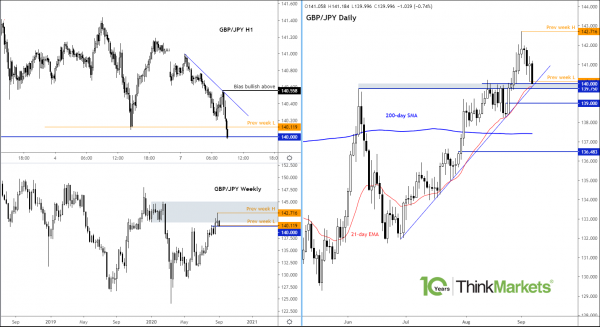Brexit developments over the weekend added to the pessimism that an agreement will be reached with the EU ahead of the October deadline. Boris Johnson was expected to announce that if no deal is reached by October 15th, then both the EU and the UK should “move on”. The British government is also expected to announce plans for legislation that would override a key part of the EU withdrawal agreement in a bill expected to be a “standby” in case of no deal. Meanwhile concerns were also raised as the UK reported almost 3,000 new virus cases on Sunday compared to 1,813 the day before, the largest increase since 23rd May. Today’s price action in the pound suggest the likelihood of a trade agreement has decreased with some investors speculating that the possibility of a no deal Brexit has now become a probable outcome. However, I think this is all part of negotiation tactics and in the end a cliff edge Brexit will probably be avoided as it is not in either party’s interests. Indeed, there was similar posturing by both sides before the previous agreement was struck. If investors were truly concerned that we were heading for a no deal Brexit, then the pound should be no where as high as it is right now. Quite the contrary, sterling has been gaining ground in the face of rising Brexit-related uncertainty over the past several months, and so I wouldn’t be surprised that the latest weakness proves to be short-lived as well.
That being said, the longer the standoff continues, the more worried investors will become about a no deal exit. And that is what matters in so far as the pound is concerned, not what you or I think will happen. So, it is quite possible that the pound may extend its short-term declines even if we all know that both sides will try everything to avoid a messy exit in the end.
So, Brexit will unfortunately remain a key focus point and investors will be keen to see if any progress will be made as talks continue this Tuesday. A no deal exit will be the last thing the UK and Eurozone economies need right now as authorities deal with the economic impact of the pandemic.
GBP/JPY one to watch
Among the pound crosses, the GBP/JPY is an interesting one to watch – not only because of the renewed weakness for the pound, but also due to the yen’s perceived status as a haven currency with stocks coming under a bit of pressure of late. However, while the GBP/JPY may be down, it is not out. It is important not to get carried away as the trend for this pair is still bullish, which means rates could easily rebound – even if this scenario looks less likely.
Starting with the higher time frame analysis, the Guppy last week created a doji-like candle on its weekly chart with a large-ish wick around a key resistance zone (see shaded region on weekly). However, on the daily, some of the key support levels and other technical indicators remained intact at the time of writing. For example, price was still holding its own above the 21-day exponential moving average and the bullish trend line, as well as horizontal support in the range between 139.75 and 140.00.
While a breakdown appears imminent, it is worth remembering that the trend is still objectively bullish for this pair and so it could easily bounce from here. Thus, the bears may wish to keep a close eye on rates and watch for a confirmed breakdown below the 139.75-140.00 support range by means of a daily close, before looking for any potential shorting opportunities. The bulls meanwhile may consider looking for longs around this key support zone on the back of some short-term bullish price action on smaller time frames, or ideally wait for a key bullish trigger such as a break above the recent high on the hourly chart at 140.55.














